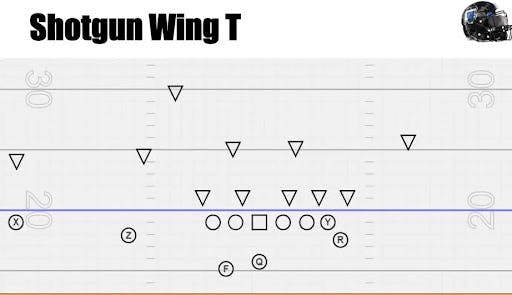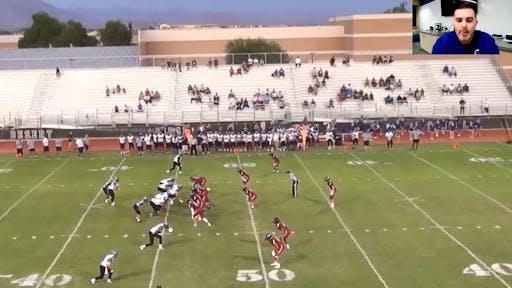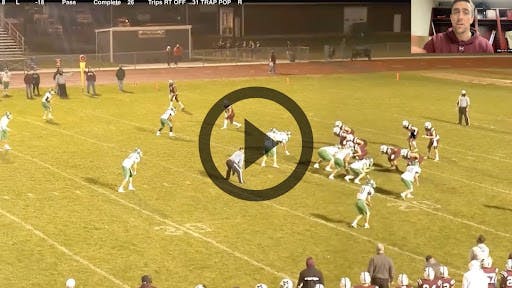Game Changer RPO Football : Wing-T Offense
- By Andrew Dohre
In the evolving game of football, offensive strategies are continuously changing to stay one step ahead of defensive schemes. One such evolution is the incorporation of the Run-Pass Option (RPO)on (RPO) into the traditional Wing-T offense offense. The Wing-T has long been the standard of high school and college football, known for its out of the box formations and deceptive running plays. But as defenses adapt, coaches are looking for innovative ways to take advantage of their offensive strengths. Enter the RPO—a game-changing concept that is giving Wing-T teams new life.
The Starting Point: Moving Out of the Traditional Under Center Formation
Before diving into the specific RPO Offense concepts, it’s important to establish one key point: to successfully run an RPO in the Wing-T offense, you need to make the shift from under center to the shotgun formation. Why? The change in positioning immediately creates a better perspective for both the quarterback and the offense as a whole to execute successfully.

When a Wing-T team lines up under center, it typically sees eight or more defenders in the box. This formation can often lead to unfavorable run situations, as there are simply more defenders in the area where the offense plans to run the ball. By transitioning to the shotgun formation and spreading out a receiver or two, the offense can gain a better count of defenders in the box, giving them a better opportunity to exploit mismatches in both the run and pass game.
This was something Nick Gerhts Gerhts, the head coach of Canyon View High School in Arizona, immediately recognized as a significant benefit. In his view, the move to the shotgun offers a clearer look at the defense, creating more opportunities for both the passing and running game. As Coach Gerhts explains in his video breakdowns, the key is not just the shotgun formation itself, but the variety of RPO concepts that can be run once you’re in that setup.
Three Key RPOs for the Wing-T Offense
Once the offense is set up in the shotgun formation, the possibilities for incorporating RPOs to your playbook are infinite. Let’s take a look at three specific RPO concepts that can be run within a Wing-T scheme, each one simple to execute yet capable of creating explosive plays.
1. The "Chevy" RPO: A Simple, Effective Hitch Route
Coach Gerhts is a firm believer in keeping things simple, and one of his favorite RPO concepts is the "Chevy". This RPO play combines a Belly running play with a quick passing option: the hitch route. The idea is to have the quarterback read the defense and make a quick decision.

Execution: The offense runs a Belly play to the right. The quarterback has 3 receivers running short hitches—one to each side of the field. If the quarterback notices an open window with one of the receivers, he throws a quick hitch route. If no one is open, or if the secondary is playing well against the pass, the quarterback hands the ball off to the running back on the Belly play.
Why It Works: The simplicity of the hitch route makes it an easy and consistent throw for the quarterback. Since it is a quick pass, it does not require elite arm strength, making it accessible to almost any quarterback. Note, for this RPO play, quarterbacks should be aware of throwing the ball too much inside on the hitch route, as it increases the chance of being picked off. By pairing the hitch route with the Belly run, this RPO effectively keeps the defense honest and forces them to respect both the run and the pass, keeping the defense off balance.
2. The "Buck Out" RPO: Using the Speed Out to Stretch the Defense
The next RPO concept to consider adding to your playbook is the "Buck Out" RPOOut" RPO, which pairs the Buck Sweep with a speed out route for the receiver. The speed out is a quick, boundary-oriented route that is incredibly effective against soft cornerbacks or defenses that are overplaying the inside running game. Coach Danny Norris explains:
Execution: In this RPO, the offense runs a Buck Sweep, a traditional Wing-T running play designed to stretch the defense horizontally. The quarterback has the option to throw a quick speed out to the receiver lined up on the boundary. This route gets the receiver away from the outside linebacker and provides a quick pass option for the quarterback if the defense is giving up space on the edge.
Why It Works: The Buck Sweep Sweep is a well-established play in the Wing-T offense, and the addition of the speed out route puts even more pressure on the defense. The defense now has to cover both the outside and inside of the field, stretching their coverage and creating more opportunities for big plays. Because the receiver and running bak are moving in opposite directions, this exposes the defense and allows the quarterback to make an easy read. Plus, just like the Chevy RPO, the speed out requires minimal arm strength, making it a viable option for almost any quarterback.
3. The "Trap Pop" RPO: Exploiting the Guard Pull with a Short Throw
The third RPO concept is the "Trap Pop"rap Pop", which leverages the well-known Trap running play and adds an effective short passing option. The Trap is a highly successful run play, but without an RPO tag, it can sometimes attract too many defenders to the line of scrimmage, particularly linebackers who are disciplined in reading their keys. The Trap Pop RPO fixes that by introducing a quick pass to exploit the resulting defensive movement. Coach Mike Morrisey of Moline HS explains the “Trap Pop” RPO play here:

Execution: The offense runs a Trap play, where the guard pulls and leads the running back through a hole in the defense. The linebackers, reading the run, flow toward the trap action. As they do, the quarterback has the option to throw a short pass, known as the Pop pass, to a receiver or tight end who is likely to be open due to the defensive shift created by the guard pull. The pass is short, making it easy for the quarterback to execute, but it can open up a huge seam in the defense, allowing your big tight end or receiver to make a play in open space.
Why It Works: The Trap play is a strong running scheme, but it often draws extra defenders into the box. By pairing it with a quick Pop pass, the offense can take advantage of this extra pressure and find a vulnerable area in the defense. The beauty of this RPO is that the pass is short and simple, yet it can lead to big plays when executed well due to how it spreads the defense.
The Beauty of RPOs in the Wing-T Offense
What makes these RPO concepts so valuable in the Wing-T offense is that they do not require elite arm talent to be effective. The passes in all three RPOs—Chevy, Buck Out, and Trap Pop—are short and simple, but they create huge advantages for the offense. The key to success is the ability to read the defense quickly and make a fast decision, something that any quarterback can do with some training and practice.
These RPOs give the Wing-T offense a modern twist, allowing coaches and players to continue using the traditional running schemes they know while adding an additional layer of complexity to confuse the defense. The end result is an offense that is difficult to defend, forces the defense to respect both the run and pass, and keeps defenses on their toes throughout the game.
Conclusion: Always Be Growing
Incorporating RPOs into the Wing-T offense is a simple yet powerful way to stay ahead of the defense. As coaches like Nick Gerhts, Danny Norris, and Mike Morrisey have demonstrated, adding just a few RPO concepts to your playbook can have a massive impact on your ability to stretch the defense and make big plays. Whether you’re running a simple hitch route, a speed out, or an explosive Trap Pop, RPO plays provide a way to keep the defense guessing and create a more dynamic offense in this ever changing era of offensive football.




No comments:
Post a Comment